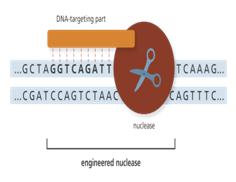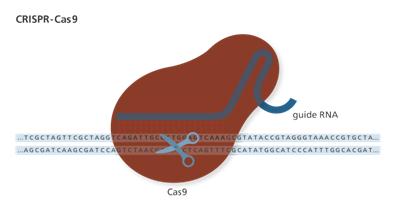

Gene editing is a rapidly developing area of biotechnology, it allow the precisely change the nucleotide sequence of the genome of living cells. However, development of ethical and regulatory frameworks that ensure their safe and effective use is an increasingly important consideration.
Context
Gene editing is a rapidly developing area of biotechnology, it allow the precisely change the nucleotide sequence of the genome of living cells. However, development of ethical and regulatory frameworks that ensure their safe and effective use is an increasingly important consideration.
Background
- The label ‘genome editing technologies’ commonly refers to technologies that allow scientists to make changes in the genetic sequences of organisms.
- As momentum builds around genome editing technologies, a substantial debate has developed amongst scholars from a wide range of disciplines, national academies, ethics bodies, members of the public, learned societies, and patients.
- This debate concerns the ethical acceptability of its human applications, among others, and the mechanisms of governance that would be needed to regulate these applications.
Analysis
What is Genome editing?
- Genome editing is a technique used to precisely and efficiently modify DNA within a cell leading to changes in physical traits, like eye color, and disease risk.
- The technique involves making cuts at specific DNA sequences with enzymes known as ‘engineered nucleases’.
- The technology can be used to add, remove, or even alter DNA in the genome.
- By editing the genome, the characteristics of a cell or an organism can be changed easily.
|
How is it done?
|
Which genome editing technologies are currently in use?
- Current genome editing technologies include zinc-finger nucleases (ZFNs), transcription activator-like effector-based nucleases (TALENs) and clustered regularly interspaced short palindromic repeats (CRISPR), with CRISPR-associated nucleases (Cas).
- CRISPR-based genome editing is considered more precise (it is possible to target specific sequences of DNA), more efficient (it has relatively few off-target effects) and cheaper to use than other genome editing technologies.
|
CRISPR-Cas9
|
What are its major applications?
Investigation of disease
- Scientists use genome editing to investigate different diseases that affect humans.
- They edit the genomes of animals, like mice and zebrafish, because animals have many of the same genesas humans.
- For example, mice and humans share about 85 percent of their genes.
- By changing a single gene or multiple genes in a mouse, scientists can observe how these changes affect the mouse's health and predict how similar changes in human genomes might affect human health.
Treatment of Disease
- Scientists are developing gene therapies- treatments involving genome editing - to prevent and treat diseases in humans.
- Genome editing tools have the potential to help treat diseases with a genomic basis, like cystic fibrosis and diabetes.
- There are two different categories of gene therapies: germline therapy and somatic therapy.
- Germline therapies change DNA in reproductive cells (like sperm and eggs). Changes to the DNA of reproductive cells are passed down from generation to generation.
- Somatic therapies, on the other hand, target non-reproductive cells, and changes made in these cells affect only the person who receives the gene therapy.
How countries across the world are progressing towards genome editing?
- Countries across the world, except for the European Union, are relaxing biosafety norms for using gene editing for knock-out mutations and for creating more desirable allelic forms of a vital gene.
- An example of gene editing in plants is knocking off wheat genes that cause high susceptibility to the powdery mildew disease.
- The US and Europe are still at the forefront in generating knowledge, but others are catching up by developing competency in new areas of R&D.
- Chinese laboratories have excelled in genomics research and now, in plant genome editing.
- In comparison, in India, the country seems to be in no hurry to take vital decisions on the use of new technologies.
- Promising regions & countries for genome editing:
- North America ( United States)
- Europe ( Germany, France, UK)
- Asia-Pacific ( China, Japan, India)
- Latin America ( Brazil)
- The Middle East & Africa
What are the ethical concerns for using genome editing?
- Safety concerns: Due to the possibility of off-target effects i.e., edits in the wrong place and mosaicism i.e., when some cells carry the edit but others do not, safety is of primary concern.
- Use of embryos: Since human embryos are humans in the earliest developmental stage, their destruction raises ethical questions.
- Risk to life and health: Egg donation specifically for the purpose of research raises additional concerns. Oocyte procurement is a physically invasive procedure, which involves ovarian suppression, followed by ovarian stimulation and a surgical procedure of oocyte retrieval. The whole process involves not only many inconveniences, but also risks to the physical health or even the life of the woman involved.
- No informed consent: In gene editing, it is impossible to obtain informed consent for germline therapy because the patients affected by the edits are the embryo and future generations.
- Not accessible to all: There is also a concern that genome editing will only be accessible to the wealthy. This will increase existing disparities in access to health care and other interventions.
- Inadequate guidelines: Current national and international regulations provide inadequate guidance and oversight for these applications. As such, they do not foster public trust in the safety of CRISPR?edited organisms or the regulatory agencies charged with monitoring them.
- National and international security: Recent advancements in gene editing also have serious implications for national and international security. CRISPR/Cas9 can modify pathogens to increase their virulence, expand their host range, increase their transmissibility, and enhance natural resistances to therapeutic interventions.
|
The ethical questions
|
Conclusion
Genome editing technologies hold potential for many sectors of the Indian economy, where agriculture assumes prominence in the mostly agrarian society. However, ethical concerns bring into sharp focus the possible pitfalls of gene editing. With effective policy formulation and strict regulation, things can be improved. Countries across the world, need to develop a uniform format to register all human gene editing experiments in their individual countries.




